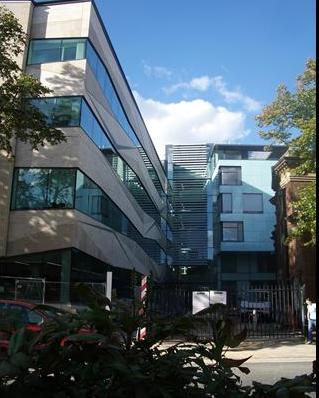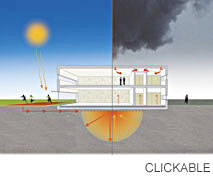Planning a Soft Landing – on Large Ground Source Energy Projects
by Edward Thompson
The CIBSE Journal of August 2013 includes a key article on the ground source energy installation at the Department of Earth Sciences for Oxford University: All hands to the Pump.
ICAX were not involved in this project, but there are lessons to be learned from what went wrong and how it was put right.
The Background – Department of Earth Sciences at Oxford University
The 7,100 m² building consists of five floors of offices and four stories of specialist laboratories linked by an atrium entrance. Oxford University was attracted by the predicted carbon savings of a ground source energy system that would push beyond the planning requirements and maximise the contribution from 63 boreholes beneath the £30m building.
Heating and cooling from the ground source energy was to be supplemented by gas boilers for heating and roof mounted chillers for cooling.

The Team
The CIBSE article lists the large number of organisations involved in constructing the Earth Sciences building for the client:
- Architect
- Project Manager
- M&E Consulting engineers
- Ground source installer
- Main Contractor
- M&E Contractor
- Controls Specialist
- Cost Consultant
- Structural engineer
- Planning authority
The client lost confidence in the system and turned off the ground source energy system in order to rely on the conventional back-up. Luckily there was a full back up system.
The Problems
Parts of the installation team then got together to fathom out the issues. These included:
- failure of the sliding header arrangement
- a flow meter, on which the controls system relied, had seized
- inconsistencies in the way meters had been "zeroed", which had not been identified during commissioning
- a controls alogorithm had misallocated electricity use between heating and cooling
- the controls system for the ground source energy did not communicate correctly with the main building management system
Remedial works and Optimisation leads to results
The good news is that once the problems had been located and remedied a year later and the systems had been optimised the CO2 savings were 24% better than what had originally been predicted.
Lessons learnt
The author of the original article concludes that, "If we are serious about closing the 'performance gap' we must allocate time and resources to fine tuning during the early months and years of operation".
An alternative conclusion could have been that there were too many parties involved in the job and responsibility may have fallen between the cracks.
ICAX has experience of working with others on large buildings and we would conclude that the problems encountered in this Oxford University building could have been avoided if one party had responsibility for the heating and cooling of the building, including the following roles:
- Design of the ground source energy system, including thermal modeling of the ground array
- installation of the ground source energy system
- design and installation of the Energy Management System – controls for the ground source system
- Commissioning and checking of the operation of the full system
- Monitoring the system over the first three years of use (including providing RHI data)
- Tuning the system to respond to how heating and cooling is demanded in the building – which will usually differ from the predicted loads.
Controls are critical to an efficient ground source system
The proper design and implementation of the controls is critical to providing an efficient system with good performance – particularly when there is a combination of a ground source system and conventional systems.
In a complex system it is easy to overlook key parameters and not always easy to diagnose where problems lie, especially where a number of organisations have been involved in design and implementation. It is not necessary to start afresh with each new installation and attempt to "re-invent the wheel" for each new building.
The smart alternative is to involve someone who has been through these hoops before.
ICAX projects using ground source energy systems:
Howe Dell School
| Suffolk One College
| Merton Community Centre
Tesco Supermarket
| Wellington Civic Centre
See Ground Source Heating Ground Source Cooling Ground Source Energy
"Soft Landings" means continuing involvement of designers and constructors after practical completion to help clients operate buildings and fine tune the control systems so that they get the best from their investment in buildings.



